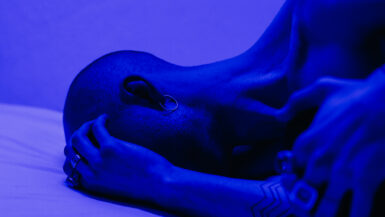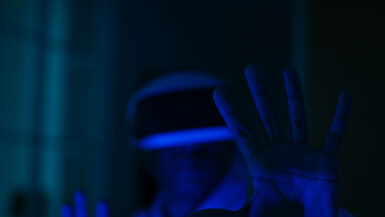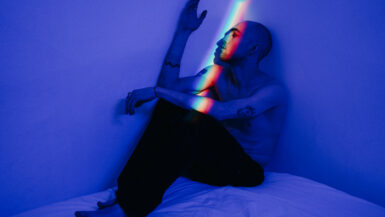In today’s technology-driven world, exposure to blue light has become an inevitable part of our daily lives. This article delves into the impact of blue light on sleep and immune function, shedding light on the science behind these effects and their implications for our overall health and productivity. As we explore the intricacies of how blue light influences our circadian rhythm and immune system, we aim to provide valuable insights that can help you make informed decisions about your exposure to this ubiquitous yet often overlooked aspect of modern living. Join us as we unravel the complex interplay between blue light, sleep, and immune function, and discover how you can harness this knowledge to enhance your well-being and productivity.
Impact of Blue Light on Circadian Rhythms
As we delve deeper into the effects of blue light on our bodies, it is crucial to understand its impact on our circadian rhythms – the internal clock that regulates our sleep-wake cycles. This section will explore the role of blue light in shaping our circadian rhythms, highlighting its potential implications for sleep quality and immune function.
Blue Light and Melatonin Suppression
One of the primary ways in which blue light affects our sleep patterns is by suppressing the production of melatonin, the hormone responsible for regulating sleep. Exposure to blue light, especially during the evening hours, can delay the onset of melatonin production, making it more difficult for us to fall asleep. Consequently, this disruption in our sleep-wake cycle can have a ripple effect on our overall health and productivity.
Effects on Sleep Quality and Duration
The impact of blue light on sleep is not limited to melatonin suppression alone. Studies have shown that exposure to blue light can also affect the quality and duration of our sleep. Prolonged exposure to blue light during the night can lead to fragmented and less restorative sleep, resulting in feelings of grogginess and fatigue the following day. This can, in turn, impair our cognitive performance and productivity levels.
Implications for Immune Function
The connection between blue light and sleep is not only relevant for our cognitive abilities but also for our immune function. Chronic sleep disruption has been linked to a weakened immune system, making us more susceptible to infections and illnesses. By interfering with our sleep patterns, blue light exposure can indirectly compromise our immune function, leaving us more vulnerable to health issues.
The Connection Between Blue Light and Sleep in Animals
Interestingly, the effects of blue light on sleep and immune function extend beyond humans, with research indicating similar impacts on animals. Studies have shown that animals exposed to blue light exhibit altered sleep patterns and reduced melatonin levels, much like their human counterparts. These findings not only reinforce the significance of blue light in shaping our circadian rhythms but also underscore the need for further research in this area.
Strategies for Minimizing Blue Light Exposure
Given the potential consequences of blue light exposure on sleep and immune function, it is essential to adopt strategies that can help minimize its impact. This can include using blue light filtering screens or apps on electronic devices, wearing blue light blocking glasses, and establishing a consistent sleep schedule. Implementing these strategies can help mitigate the effects of blue light on our circadian rhythms, promoting better sleep quality and bolstering our immune function.
As our understanding of the relationship between blue light, sleep, and immune function continues to evolve, it becomes increasingly clear that managing our exposure to blue light is critical for maintaining optimal health and productivity. By taking proactive steps to reduce blue light exposure and prioritize good sleep hygiene, we can harness the power of our circadian rhythms to enhance our well-being and performance in both our personal and professional lives.
Effective Ways to Reduce Blue Light Exposure
As we become increasingly aware of the potential consequences of blue light exposure on sleep and immune function, it is essential to implement practical and effective strategies for reducing our exposure to this ubiquitous source of artificial light. This section will provide an overview of several proven methods for minimizing blue light exposure, helping you to safeguard your sleep and immune function while maintaining a healthy, balanced lifestyle.
Embrace the Use of Blue Light Blocking Technology
One of the most straightforward ways to reduce blue light exposure is by leveraging technology designed to filter out this harmful spectrum of light. Blue light blocking apps and screen protectors can be installed on smartphones, tablets, and computer screens to minimize eye strain and reduce the impact of blue light on your sleep patterns. Similarly, investing in a pair of blue light blocking glasses can provide added protection, especially during extended periods of screen time.
Establish a Digital Curfew
Creating a digital curfew, where you abstain from using electronic devices at least one hour before bedtime, can significantly reduce your exposure to blue light during the critical hours leading up to sleep. This practice not only helps to minimize the impact of blue light on melatonin production but also allows your mind to unwind and prepare for a restful night’s sleep.
Opt for Warm Lighting in the Evening
In the evening hours, it is best to switch from cool, white light sources to warmer, amber-hued lighting. This can help to reduce the amount of blue light emitted by your home’s lighting and create a more sleep-friendly environment. Consider using smart bulbs that allow you to adjust the color temperature or invest in lamps with warm, incandescent light bulbs.
Create a Sleep-Friendly Environment
In addition to managing blue light exposure, it is essential to create a sleep-friendly environment that promotes relaxation and rest. This can include maintaining a cool, dark, and quiet bedroom, investing in a comfortable mattress and bedding, and incorporating relaxation techniques such as deep breathing or meditation before bedtime.
The Influence of Blue Light on Learning and Memory
Interestingly, blue light exposure has been linked to not only sleep and immune function but also learning and memory processes. By effectively managing blue light exposure in our daily lives, we can mitigate its potential adverse effects on cognitive performance, further supporting our overall health and well-being.
As we navigate the challenges of modern living, it is essential to prioritize the quality of our sleep and the health of our immune system. By implementing the strategies outlined above, we can effectively reduce blue light exposure and foster a lifestyle that supports optimal rest, resilience, and productivity. With the right tools and practices in place, we can harness the power of our circadian rhythms to enhance our overall well-being and performance in all aspects of life.
Blue Light’s Influence on Productivity and Performance
The impact of blue light on sleep and immune function extends beyond our physical well-being, with studies suggesting a significant connection between blue light exposure and our cognitive performance. This subsection delves into the intricate relationship between blue light, productivity, and performance, highlighting the potential implications of excessive blue light exposure on our ability to focus, learn, and perform at our best.
Effects on Attention and Focus
One of the critical aspects of productivity and performance is our ability to maintain attention and focus on tasks. Research has shown that exposure to blue light, particularly in the evening, can impede our capacity to concentrate. By disrupting our sleep patterns and impairing the production of melatonin, blue light exposure can leave us feeling fatigued and less alert during the day, ultimately affecting our ability to stay focused and productive.
Disruption of Learning and Memory Processes
In addition to its impact on attention and focus, blue light exposure has been linked to disruptions in learning and memory processes. Studies have shown that inadequate sleep, which can result from excessive blue light exposure, can negatively affect our ability to retain and process new information. This can result in diminished cognitive performance and reduced productivity, particularly in tasks requiring problem-solving and critical thinking skills.
Implications for Workplace Performance
The influence of blue light on productivity and performance is particularly relevant in the context of workplace settings. With the increasing prevalence of technology and screen-based work, employees are more exposed to blue light than ever before. This can lead to a vicious cycle of disrupted sleep and lower productivity, ultimately affecting overall job performance and satisfaction. As such, it is crucial for both employers and employees to recognize the potential implications of excessive blue light exposure and implement strategies to mitigate its impact.
Optimizing Blue Light Exposure for Enhanced Productivity
While the potential negative effects of blue light on productivity and performance are undeniable, it is essential to note that blue light is not inherently harmful. In fact, exposure to blue light during the day can help regulate our circadian rhythms and boost alertness, promoting optimal cognitive performance. By managing our exposure to blue light effectively, we can strike a balance that supports both our physical and mental well-being.
Adopting Healthy Habits to Support Productivity
In addition to managing blue light exposure, adopting healthy habits that support productivity and mental well-being is essential. This can include engaging in regular physical activity, maintaining a balanced diet, and practicing stress-reduction techniques, all of which can contribute to improved cognitive performance and overall well-being.
The complex relationship between blue light, productivity, and performance underscores the importance of managing our exposure to this pervasive aspect of modern living. By understanding the potential impact of blue light on our cognitive abilities and implementing strategies to minimize its adverse effects, we can foster a lifestyle that supports optimal productivity, performance, and well-being. Ultimately, this knowledge empowers us to make informed decisions about our daily habits, enabling us to thrive both personally and professionally.
Understanding Blue Light and Its Sources
As we delve into the effects of blue light on our sleep and immune function, it is essential to develop a clear understanding of what blue light is and its primary sources. This subsection will provide an overview of blue light, its origin, and the various ways in which we are exposed to it in our daily lives. By gaining insight into the nature and sources of blue light, we can better comprehend its impact on our well-being and devise strategies to mitigate its potential adverse effects.
Defining Blue Light and Its Characteristics
Blue light is a portion of the visible light spectrum with a wavelength range of approximately 400-500 nanometers (nm). It is characterized by its high-energy output and short wavelengths, which contribute to its ability to penetrate and affect our eyes and internal biological processes. While blue light is a natural component of sunlight, it is also emitted by various artificial sources, making it an ever-present aspect of our environment.
The Sun: A Natural Source of Blue Light
Sunlight is the primary natural source of blue light, providing essential exposure that helps regulate our circadian rhythms and maintain overall health. During daylight hours, exposure to blue light from the sun can enhance alertness and mood, promoting optimal cognitive performance. However, it is crucial to balance sunlight exposure with proper protection, such as wearing sunglasses with UV protection, to reduce the risk of eye damage and other health concerns.
Artificial Sources: Electronic Devices and LED Lighting
In addition to sunlight, blue light is emitted by various artificial sources that have become integral to our modern lives. Electronic devices such as smartphones, tablets, computers, and televisions produce blue light, exposing us to this high-energy wavelength during extended periods of screen time. Additionally, LED and fluorescent lighting, which are commonly used in homes and workplaces, also emit blue light, further contributing to our overall exposure.
Blue Light Exposure: Striking the Right Balance
While blue light is a natural and essential part of our environment, it is critical to strike the right balance in our exposure to it. Excessive exposure to blue light, particularly during the evening hours, can disrupt our sleep patterns and compromise our immune function. To maintain optimal health, it is crucial to be aware of our blue light exposure from both natural and artificial sources and adopt strategies to manage it effectively.
Recognizing the Importance of Blue Light Awareness
As we become increasingly aware of the potential consequences of blue light exposure, it is essential to acknowledge the importance of blue light awareness in our daily lives. By understanding the nature and sources of blue light, we can make informed decisions about our habits and adopt practices that minimize its negative impact on our sleep, immune function, and overall well-being.
In summary, understanding blue light and its sources is a fundamental aspect of grasping its impact on sleep and immune function. By recognizing the nature of blue light and the various ways in which we are exposed to it, we can better appreciate its role in our health and take appropriate steps to manage our exposure. This knowledge empowers us to cultivate a lifestyle that fosters balance, resilience, and well-being in the face of an increasingly technology-driven world.
Connection Between Blue Light Exposure and Sleep Disruption
The intricate relationship between blue light exposure and sleep disruption warrants a closer examination, as it significantly contributes to our overall health and well-being. This subsection delves into the various ways in which blue light exposure can interfere with our sleep patterns, exploring the underlying mechanisms and potential consequences of this disruption.
The Role of Blue Light in Regulating Sleep-Wake Cycles
To fully grasp the connection between blue light exposure and sleep disruption, it is essential to understand the role of blue light in regulating our sleep-wake cycles. Blue light influences the production of melatonin, a hormone that plays a crucial role in controlling our circadian rhythms. During daylight hours, blue light exposure helps maintain alertness and cognitive performance. However, excessive exposure in the evening can suppress melatonin production, leading to difficulties in falling asleep and altered sleep patterns.
Delayed Sleep Onset and Reduced Sleep Efficiency
One of the primary consequences of blue light exposure during the evening is delayed sleep onset, which refers to the time it takes for an individual to fall asleep. This delay in sleep initiation can result in reduced sleep efficiency, characterized by increased awakenings and lighter sleep stages. Consequently, individuals may experience a less restorative sleep, leading to fatigue and impaired cognitive performance the following day.
Impact on Sleep Architecture and REM Sleep
Beyond its effects on sleep onset and efficiency, blue light exposure has also been found to impact sleep architecture, specifically the distribution of different sleep stages throughout the night. Research has shown that excessive blue light exposure can lead to a reduction in rapid eye movement (REM) sleep, a crucial sleep stage for memory consolidation and emotional regulation. This disruption in sleep architecture can further exacerbate the negative effects of sleep disruption on cognitive performance and emotional well-being.
Long-Term Consequences of Sleep Disruption
Chronic sleep disruption, which can result from ongoing blue light exposure, has been linked to various long-term health consequences. These include an increased risk of obesity, diabetes, cardiovascular disease, and mood disorders. As such, it is vital to recognize the potential impact of blue light exposure on sleep and adopt strategies to mitigate these effects.
Individual Differences in Susceptibility to Blue Light Exposure
It is important to note that individual differences in susceptibility to blue light exposure can influence the extent to which sleep is disrupted. Factors such as age, genetics, and lifestyle can all play a role in determining an individual’s sensitivity to blue light and its effects on sleep. By acknowledging these differences, we can tailor our approach to managing blue light exposure and prioritize sleep hygiene based on individual needs.
The connection between blue light exposure and sleep disruption is a critical aspect of understanding the broader implications of blue light on our health and well-being. By examining the various ways in which blue light interferes with sleep patterns and recognizing the potential consequences of this disruption, we can make informed decisions about our lifestyle and habits. Ultimately, this knowledge empowers us to cultivate a balanced approach to blue light exposure, fostering optimal sleep, immune function, and overall health.





Leave a reply